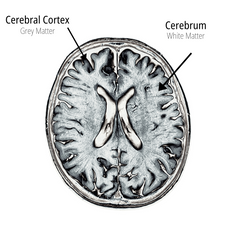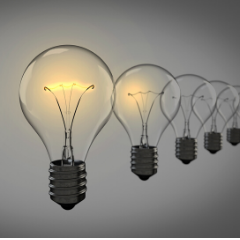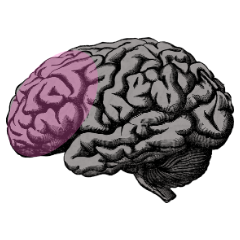
Yoga changes your body but have you considered how, if at all, yoga could change your brain?
Grey Matter(s)
Research studies have found that people who practice yoga regularly have more grey matter volume than people who are matched with them in every other way but don't practice yoga - called matched controls (Villemure et al 2015). Grey matter makes up around 40% of your total brain volume (the other 60% being white matter) and it is mostly comprised of neurons (the nerve cells that transmit information to other cells). Your cerebral cortex, the crinkly outer surface of your brain is made of grey matter.

Figure 1. Transverse view of the human brain showing the cerebral cortex (grey matter).
In fact despite ranging from only 1mm to 4.5mm thick, the cerebral cortex has 14 to 16 billion neurons packed into its folds (called sulcus or sulci) and ridges (gyrus or gyri). Covering the two halves (left and right) of the cerebrum the cerebral cortex is further classed into four regions or lobes. These are the frontal lobe, parietal lobe, occipital lobe and the temporal lobe. Also packed into your skull are your cerebellum or 'little brain' sitting just below your occipital lobe that also contains grey matter as does your brainstem connecting the whole shebang to your spinal cord.
So where do yogis stash their extra grey matter? And does having more of something always equal better? More weeds don't make a better garden. So does that extra grey matter, matter?
A Quick Lap Around the Brain.
Despite weighing only 2% of our total body weight, our brains use 20% of the energy we consume just to keep it ticking over. The surface area of the cerebral cortex is much larger than it looks and would cover 1500 to 2000 square cm's if you unfolded it all. It's also pretty electric, producing enough energy to power a light bulb.

Figure 2. Bright Spark! Your brain produces enough energy to power a light bulb.
The frontal lobe is home to our executive function, attention, reward, working memory, planning and motivation. Very useful functions like remembering to pay bills, knowing what to say (and what NOT to say) in a meeting, and deciding to go to yoga instead of staying home to watch Netflix. The parietal lobe is involved in spacial perception or proprioception, navigation as well as our sense of touch. The occipital lobe, despite being curiously located at the rear of the brain, is directly responsible for the visual processing, colour differentiation and perception of motion.

Figure 3: Regions of the brain including the cerebellum and brainstem.
The temporal lobe holds long term memories, auditory processes (hearing) and the interpretation of visual stimuli such as what a facial expression means. The cerebellum helps keep us standing on one leg for standing bow, maintaining balance and coordinating movement (amongst many things) and the brain stem manages many of the critical things you do without thinking - breathe, swallow, digestion and reflexes.
Yoga and Cortical Thickness
One study, published in Frontiers of Aging Neuroscience, found women with an average of eight years of hatha yoga practice had more grey matter and greater cortical thickness than a group of matched controls. Cortical thickness is associated with cognitive preservation and cortical thinning is typically associated with ageing and declining cognitive ability. Grey matter volume is also positively associated with executive function (Laubach et al 2017).
Laubach's study found the yoga practitioners had increased cortical thickness in several lobes in the left prefrontal cortex, an important area for cognitive control.

Figure 4. Yoga is associated with increased cortical thickness in the left prefrontal cortex.
Total cumulative years of yoga practice was related to increased grey matter in several areas, including the left frontal operculum (Villemure et al. 2015). This area, located in the frontal cortex is believed to be responsible for the motor aspect of speech, music perception, some hand movements and the very important task that keeps many a households in ongoing harmony, response suppression.
Another study (Cole et al 2012) examined the connectivity of different brain regions and the relationship of that connectivity to cognition and intelligence. They wanted to understand if there was a "brain region that uses brain-wide connectivity as a central mechanism for supporting cognitive control and intelligence." They found that only the left prefrontal cortex global brain connectivity was able to predict cognitive control and fluid intelligence.

Figure 5. Yoga practice is linked with improvement in working memory, attention, verbal acquisition and other areas of executive function.
Short term yoga practice also is linked to cortical thickness. A group of women experiencing first episode psychosis had a 12 week yoga and exercise (walking and cycling) intervention (Lin et al, 2015). The group demonstrated significant improvements in working memory, verbal acquisition and attention. Their cortical thickness also increased.
SUMMARY
These studies look at different types of interventions and different yoga practices in different groups of people, so we can't conclude categorically that these results will be true for all people who do yoga. Consistently however, it appears that cortical thickness, a highly desirable quality for your brain, appears to increase in people with both a long or short term yoga practice.
Cortical thickness is positively associated with a higher IQ (link here) so there is every chance your yoga will make you smarter!
Furthermore one of the regions where grey matter increases in yogis, the left prefrontal cortex, is linked to cognitive control and fluid intelligence. It also has a big role to play in establishing positive feelings, being able to overcome any negative thoughts and feelings that arise and replacing them with a positive perspective. So if yoga gives you greater cortical thickness in that region - I'll happily take it!
Check back in our next blog to read more about how other brain changes related to can impact on your every day life.
Namaste!
PS. This is not an exhaustive representation of the published literature on yoga and the brain. I am not a neurologist, I am a yoga teacher with a strong interest in neuroscience and anatomy. I really encourage everyone to read more about this topic and feel free to ask questions in the comments section and I will endeavour to answer them in the next blog post.

Leave a comment: